CAN 256 Mental Health Assessment Task 2 Essay: Annabelle's Case
VerifiedAdded on 2020/10/23
|12
|2906
|420
Essay
AI Summary
This essay delves into the critical role of mental health assessments in providing effective care, focusing on the Mental State Examination (MSE) and psychiatric history reports. It uses the case study of a 22-year-old, Annabelle, to illustrate how healthcare providers assess mental states, particularly in young adults facing challenges like dropping out of school and social isolation. The essay explores the Recovery approach, emphasizing holistic care and patient empowerment. It examines the components of MSE, including general appearance, level of consciousness, affect, and thought processes, highlighting the importance of establishing meaningful relationships and a supportive environment for recovery. The analysis covers various aspects of Annabelle's case, such as her physical appearance, behavior, and speech patterns, and connects these observations to symptoms of mental disorders, including anxiety and potential psychotic thinking. Furthermore, it discusses the significance of setting new goals, maintaining personal hygiene, and fostering meaningful relationships as integral parts of the recovery process. The essay concludes by emphasizing the need for a structured yet flexible approach to MSE, incorporating unstructured observation and patient history to gain a comprehensive understanding of the individual's mental state. The essay also points out the importance of considering patient's environment and relationships in their recovery journey.
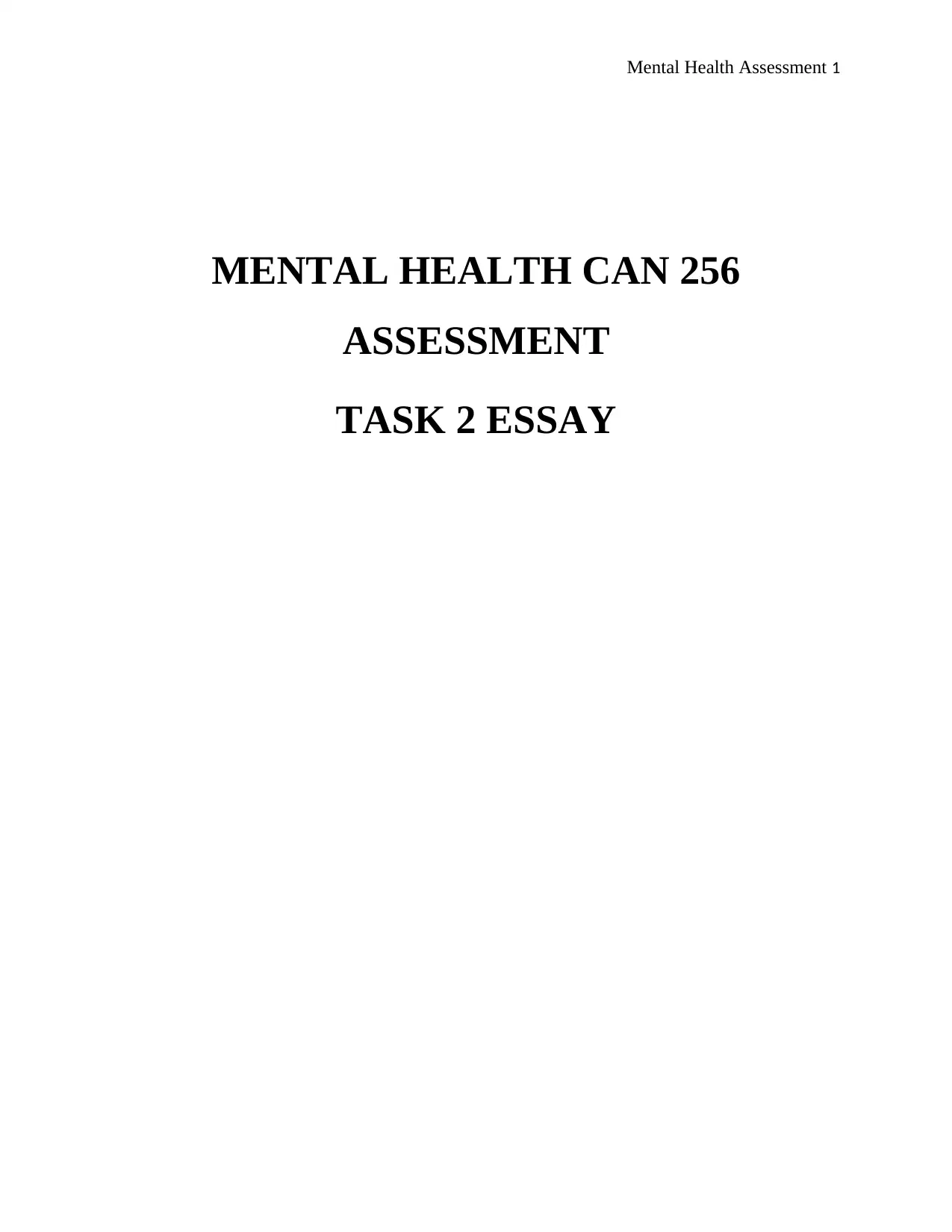
Mental Health Assessment 1
MENTAL HEALTH CAN 256
ASSESSMENT
TASK 2 ESSAY
MENTAL HEALTH CAN 256
ASSESSMENT
TASK 2 ESSAY
Paraphrase This Document
Need a fresh take? Get an instant paraphrase of this document with our AI Paraphraser
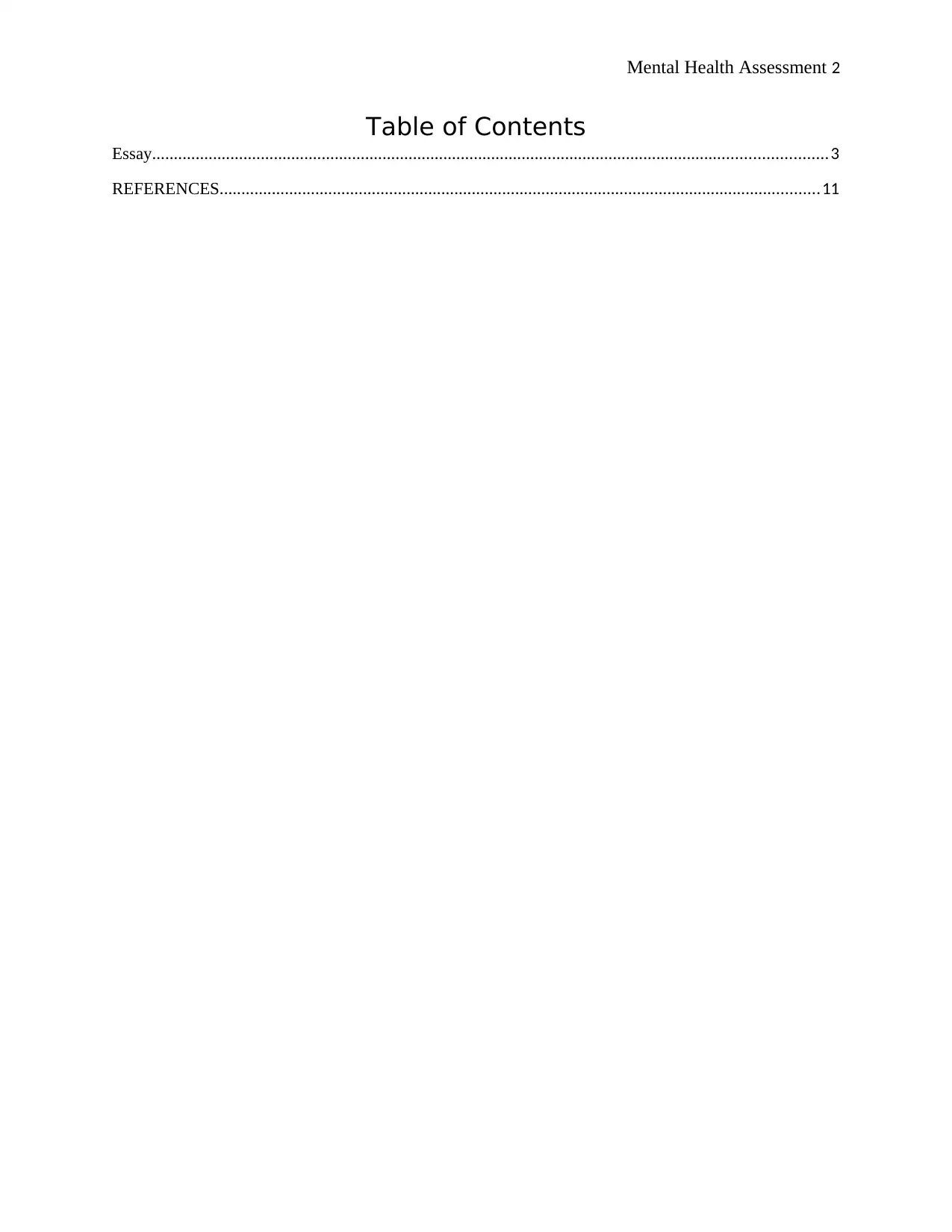
Mental Health Assessment 2
Table of Contents
Essay...........................................................................................................................................................3
REFERENCES..........................................................................................................................................11
Table of Contents
Essay...........................................................................................................................................................3
REFERENCES..........................................................................................................................................11
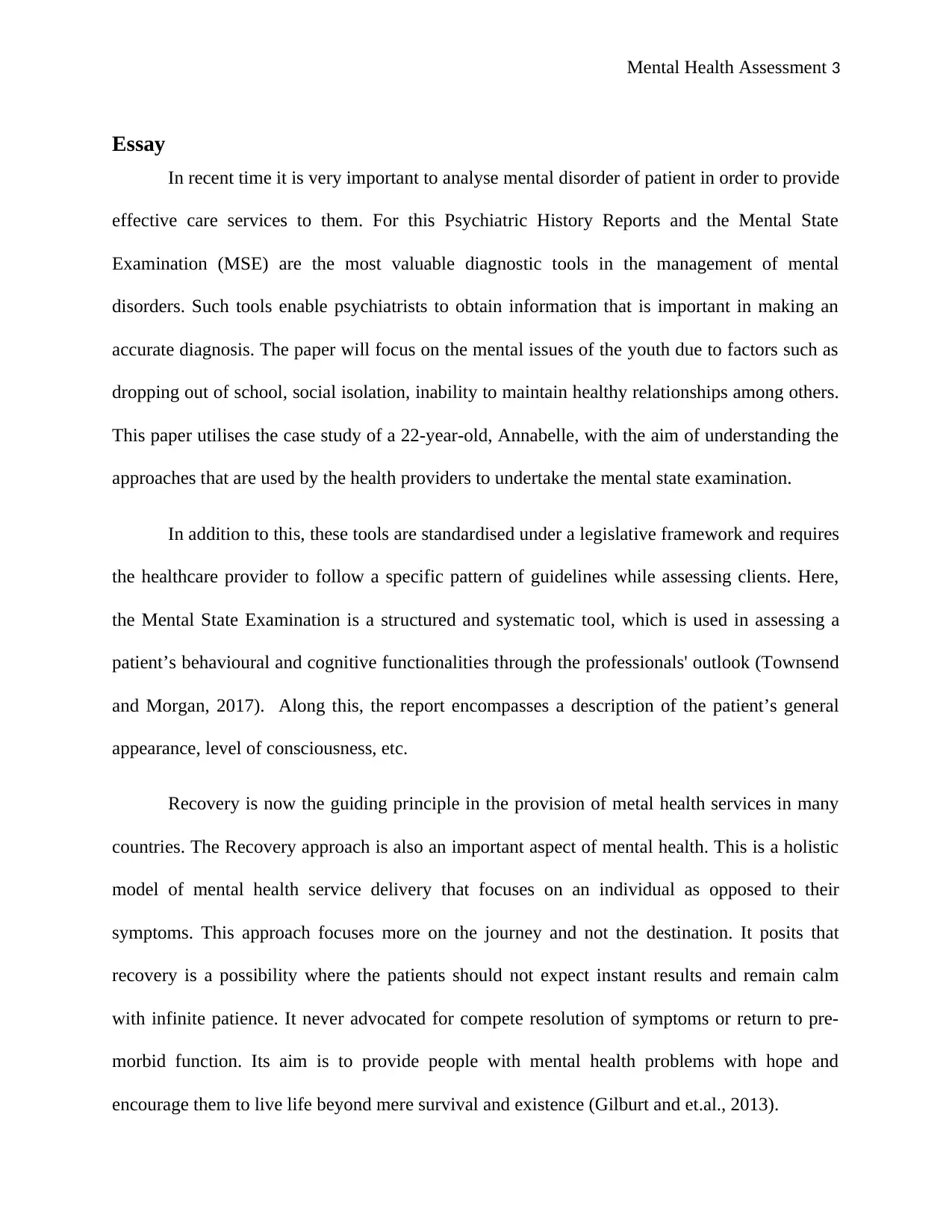
Mental Health Assessment 3
Essay
In recent time it is very important to analyse mental disorder of patient in order to provide
effective care services to them. For this Psychiatric History Reports and the Mental State
Examination (MSE) are the most valuable diagnostic tools in the management of mental
disorders. Such tools enable psychiatrists to obtain information that is important in making an
accurate diagnosis. The paper will focus on the mental issues of the youth due to factors such as
dropping out of school, social isolation, inability to maintain healthy relationships among others.
This paper utilises the case study of a 22-year-old, Annabelle, with the aim of understanding the
approaches that are used by the health providers to undertake the mental state examination.
In addition to this, these tools are standardised under a legislative framework and requires
the healthcare provider to follow a specific pattern of guidelines while assessing clients. Here,
the Mental State Examination is a structured and systematic tool, which is used in assessing a
patient’s behavioural and cognitive functionalities through the professionals' outlook (Townsend
and Morgan, 2017). Along this, the report encompasses a description of the patient’s general
appearance, level of consciousness, etc.
Recovery is now the guiding principle in the provision of metal health services in many
countries. The Recovery approach is also an important aspect of mental health. This is a holistic
model of mental health service delivery that focuses on an individual as opposed to their
symptoms. This approach focuses more on the journey and not the destination. It posits that
recovery is a possibility where the patients should not expect instant results and remain calm
with infinite patience. It never advocated for compete resolution of symptoms or return to pre-
morbid function. Its aim is to provide people with mental health problems with hope and
encourage them to live life beyond mere survival and existence (Gilburt and et.al., 2013).
Essay
In recent time it is very important to analyse mental disorder of patient in order to provide
effective care services to them. For this Psychiatric History Reports and the Mental State
Examination (MSE) are the most valuable diagnostic tools in the management of mental
disorders. Such tools enable psychiatrists to obtain information that is important in making an
accurate diagnosis. The paper will focus on the mental issues of the youth due to factors such as
dropping out of school, social isolation, inability to maintain healthy relationships among others.
This paper utilises the case study of a 22-year-old, Annabelle, with the aim of understanding the
approaches that are used by the health providers to undertake the mental state examination.
In addition to this, these tools are standardised under a legislative framework and requires
the healthcare provider to follow a specific pattern of guidelines while assessing clients. Here,
the Mental State Examination is a structured and systematic tool, which is used in assessing a
patient’s behavioural and cognitive functionalities through the professionals' outlook (Townsend
and Morgan, 2017). Along this, the report encompasses a description of the patient’s general
appearance, level of consciousness, etc.
Recovery is now the guiding principle in the provision of metal health services in many
countries. The Recovery approach is also an important aspect of mental health. This is a holistic
model of mental health service delivery that focuses on an individual as opposed to their
symptoms. This approach focuses more on the journey and not the destination. It posits that
recovery is a possibility where the patients should not expect instant results and remain calm
with infinite patience. It never advocated for compete resolution of symptoms or return to pre-
morbid function. Its aim is to provide people with mental health problems with hope and
encourage them to live life beyond mere survival and existence (Gilburt and et.al., 2013).
⊘ This is a preview!⊘
Do you want full access?
Subscribe today to unlock all pages.

Trusted by 1+ million students worldwide
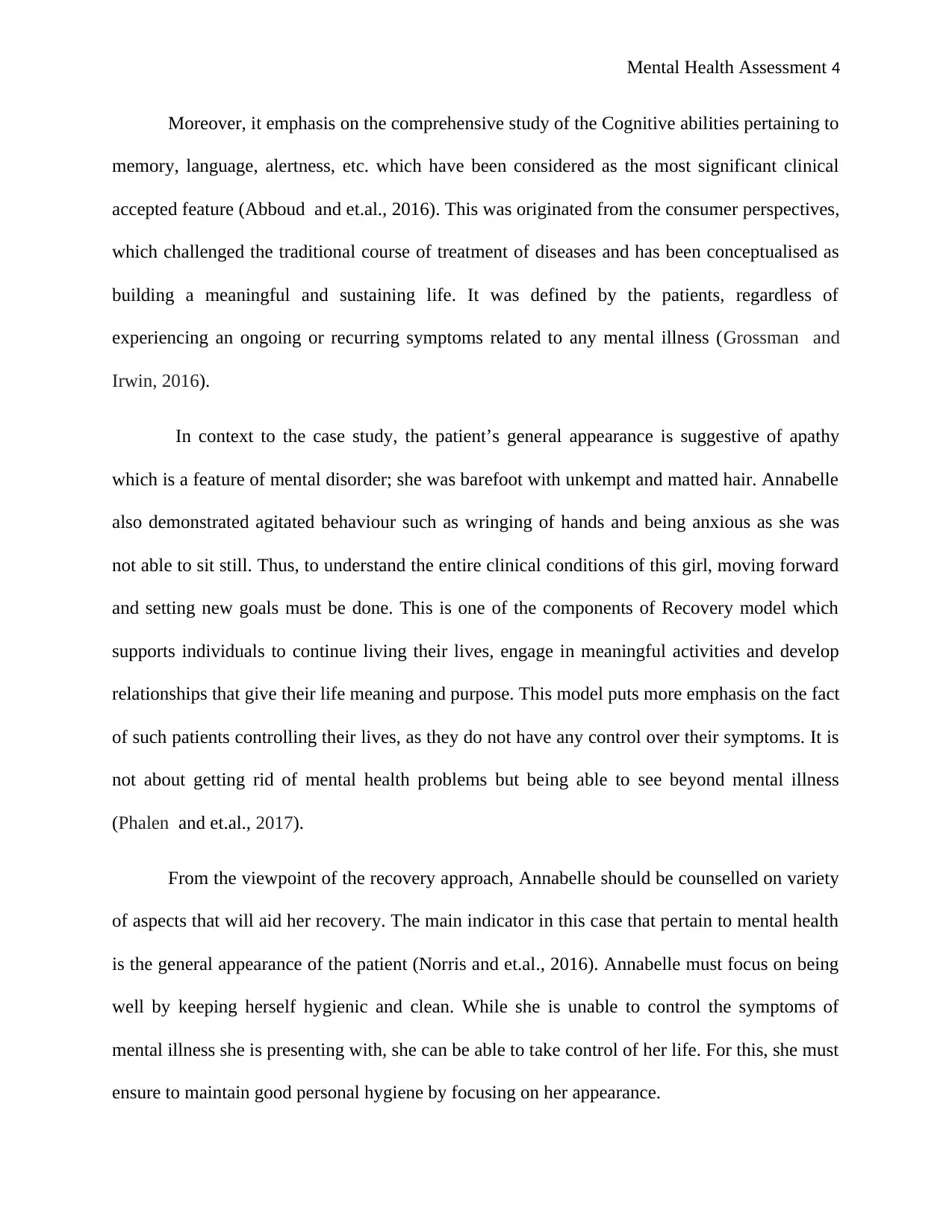
Mental Health Assessment 4
Moreover, it emphasis on the comprehensive study of the Cognitive abilities pertaining to
memory, language, alertness, etc. which have been considered as the most significant clinical
accepted feature (Abboud and et.al., 2016). This was originated from the consumer perspectives,
which challenged the traditional course of treatment of diseases and has been conceptualised as
building a meaningful and sustaining life. It was defined by the patients, regardless of
experiencing an ongoing or recurring symptoms related to any mental illness (Grossman and
Irwin, 2016).
In context to the case study, the patient’s general appearance is suggestive of apathy
which is a feature of mental disorder; she was barefoot with unkempt and matted hair. Annabelle
also demonstrated agitated behaviour such as wringing of hands and being anxious as she was
not able to sit still. Thus, to understand the entire clinical conditions of this girl, moving forward
and setting new goals must be done. This is one of the components of Recovery model which
supports individuals to continue living their lives, engage in meaningful activities and develop
relationships that give their life meaning and purpose. This model puts more emphasis on the fact
of such patients controlling their lives, as they do not have any control over their symptoms. It is
not about getting rid of mental health problems but being able to see beyond mental illness
(Phalen and et.al., 2017).
From the viewpoint of the recovery approach, Annabelle should be counselled on variety
of aspects that will aid her recovery. The main indicator in this case that pertain to mental health
is the general appearance of the patient (Norris and et.al., 2016). Annabelle must focus on being
well by keeping herself hygienic and clean. While she is unable to control the symptoms of
mental illness she is presenting with, she can be able to take control of her life. For this, she must
ensure to maintain good personal hygiene by focusing on her appearance.
Moreover, it emphasis on the comprehensive study of the Cognitive abilities pertaining to
memory, language, alertness, etc. which have been considered as the most significant clinical
accepted feature (Abboud and et.al., 2016). This was originated from the consumer perspectives,
which challenged the traditional course of treatment of diseases and has been conceptualised as
building a meaningful and sustaining life. It was defined by the patients, regardless of
experiencing an ongoing or recurring symptoms related to any mental illness (Grossman and
Irwin, 2016).
In context to the case study, the patient’s general appearance is suggestive of apathy
which is a feature of mental disorder; she was barefoot with unkempt and matted hair. Annabelle
also demonstrated agitated behaviour such as wringing of hands and being anxious as she was
not able to sit still. Thus, to understand the entire clinical conditions of this girl, moving forward
and setting new goals must be done. This is one of the components of Recovery model which
supports individuals to continue living their lives, engage in meaningful activities and develop
relationships that give their life meaning and purpose. This model puts more emphasis on the fact
of such patients controlling their lives, as they do not have any control over their symptoms. It is
not about getting rid of mental health problems but being able to see beyond mental illness
(Phalen and et.al., 2017).
From the viewpoint of the recovery approach, Annabelle should be counselled on variety
of aspects that will aid her recovery. The main indicator in this case that pertain to mental health
is the general appearance of the patient (Norris and et.al., 2016). Annabelle must focus on being
well by keeping herself hygienic and clean. While she is unable to control the symptoms of
mental illness she is presenting with, she can be able to take control of her life. For this, she must
ensure to maintain good personal hygiene by focusing on her appearance.
Paraphrase This Document
Need a fresh take? Get an instant paraphrase of this document with our AI Paraphraser
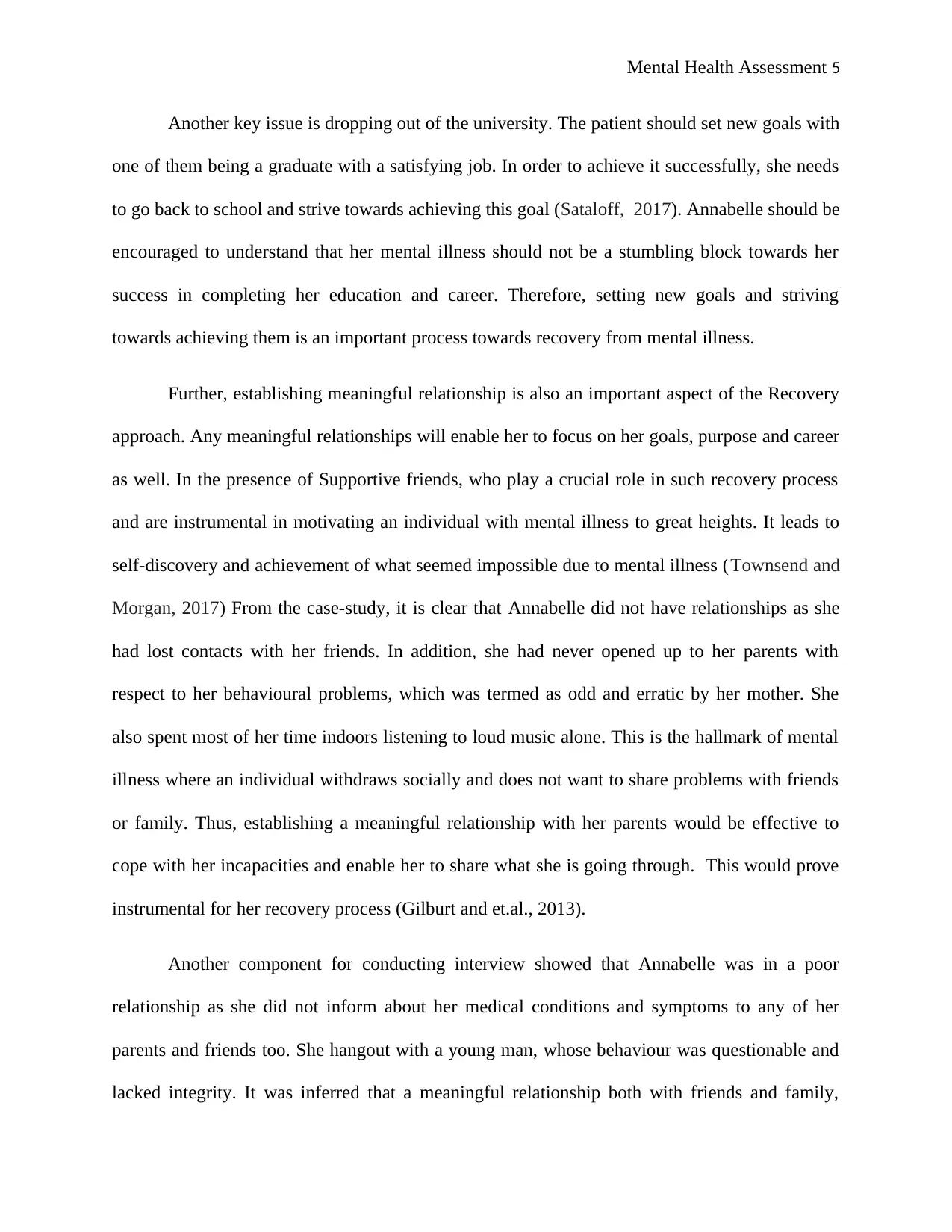
Mental Health Assessment 5
Another key issue is dropping out of the university. The patient should set new goals with
one of them being a graduate with a satisfying job. In order to achieve it successfully, she needs
to go back to school and strive towards achieving this goal (Sataloff, 2017). Annabelle should be
encouraged to understand that her mental illness should not be a stumbling block towards her
success in completing her education and career. Therefore, setting new goals and striving
towards achieving them is an important process towards recovery from mental illness.
Further, establishing meaningful relationship is also an important aspect of the Recovery
approach. Any meaningful relationships will enable her to focus on her goals, purpose and career
as well. In the presence of Supportive friends, who play a crucial role in such recovery process
and are instrumental in motivating an individual with mental illness to great heights. It leads to
self-discovery and achievement of what seemed impossible due to mental illness (Townsend and
Morgan, 2017) From the case-study, it is clear that Annabelle did not have relationships as she
had lost contacts with her friends. In addition, she had never opened up to her parents with
respect to her behavioural problems, which was termed as odd and erratic by her mother. She
also spent most of her time indoors listening to loud music alone. This is the hallmark of mental
illness where an individual withdraws socially and does not want to share problems with friends
or family. Thus, establishing a meaningful relationship with her parents would be effective to
cope with her incapacities and enable her to share what she is going through. This would prove
instrumental for her recovery process (Gilburt and et.al., 2013).
Another component for conducting interview showed that Annabelle was in a poor
relationship as she did not inform about her medical conditions and symptoms to any of her
parents and friends too. She hangout with a young man, whose behaviour was questionable and
lacked integrity. It was inferred that a meaningful relationship both with friends and family,
Another key issue is dropping out of the university. The patient should set new goals with
one of them being a graduate with a satisfying job. In order to achieve it successfully, she needs
to go back to school and strive towards achieving this goal (Sataloff, 2017). Annabelle should be
encouraged to understand that her mental illness should not be a stumbling block towards her
success in completing her education and career. Therefore, setting new goals and striving
towards achieving them is an important process towards recovery from mental illness.
Further, establishing meaningful relationship is also an important aspect of the Recovery
approach. Any meaningful relationships will enable her to focus on her goals, purpose and career
as well. In the presence of Supportive friends, who play a crucial role in such recovery process
and are instrumental in motivating an individual with mental illness to great heights. It leads to
self-discovery and achievement of what seemed impossible due to mental illness (Townsend and
Morgan, 2017) From the case-study, it is clear that Annabelle did not have relationships as she
had lost contacts with her friends. In addition, she had never opened up to her parents with
respect to her behavioural problems, which was termed as odd and erratic by her mother. She
also spent most of her time indoors listening to loud music alone. This is the hallmark of mental
illness where an individual withdraws socially and does not want to share problems with friends
or family. Thus, establishing a meaningful relationship with her parents would be effective to
cope with her incapacities and enable her to share what she is going through. This would prove
instrumental for her recovery process (Gilburt and et.al., 2013).
Another component for conducting interview showed that Annabelle was in a poor
relationship as she did not inform about her medical conditions and symptoms to any of her
parents and friends too. She hangout with a young man, whose behaviour was questionable and
lacked integrity. It was inferred that a meaningful relationship both with friends and family,
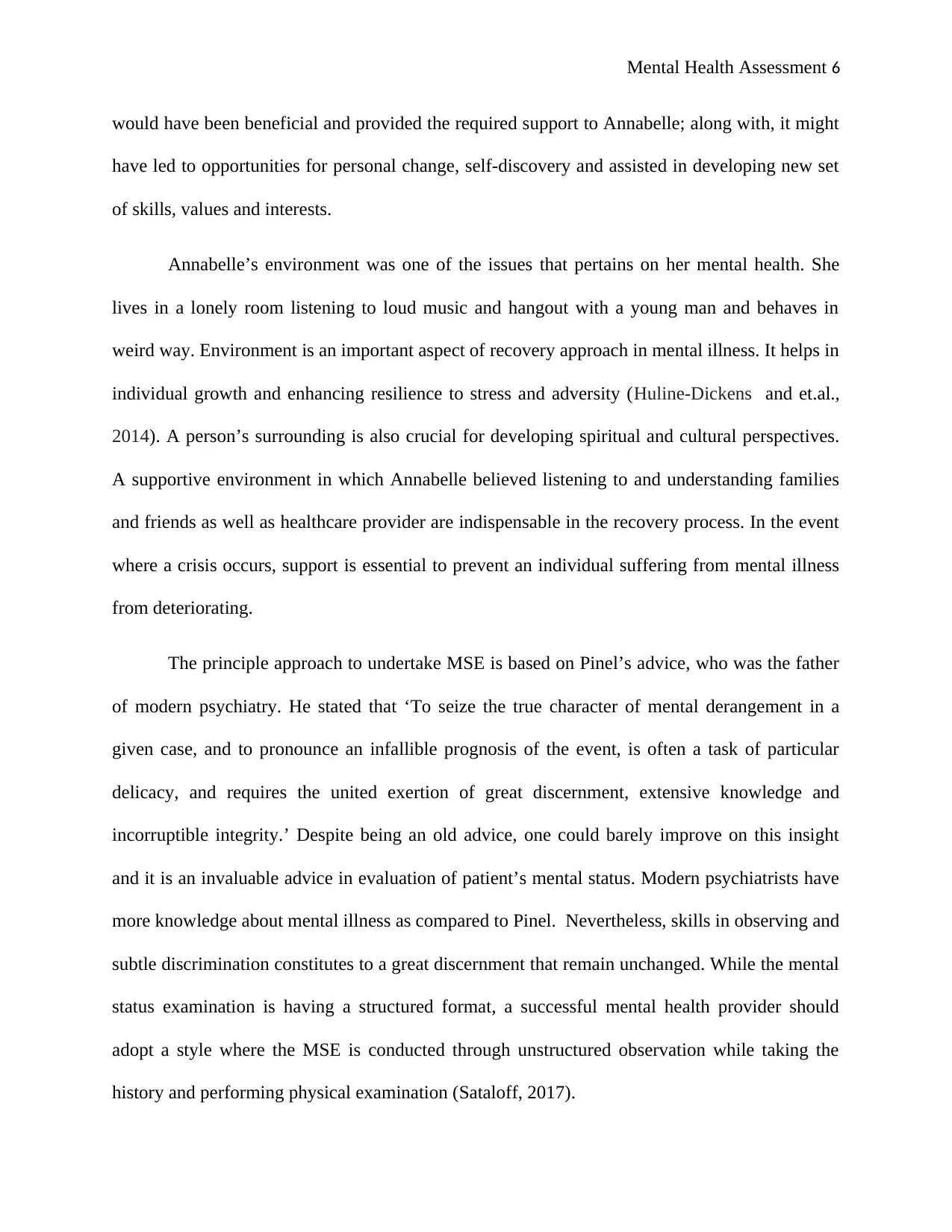
Mental Health Assessment 6
would have been beneficial and provided the required support to Annabelle; along with, it might
have led to opportunities for personal change, self-discovery and assisted in developing new set
of skills, values and interests.
Annabelle’s environment was one of the issues that pertains on her mental health. She
lives in a lonely room listening to loud music and hangout with a young man and behaves in
weird way. Environment is an important aspect of recovery approach in mental illness. It helps in
individual growth and enhancing resilience to stress and adversity (Huline-Dickens and et.al.,
2014). A person’s surrounding is also crucial for developing spiritual and cultural perspectives.
A supportive environment in which Annabelle believed listening to and understanding families
and friends as well as healthcare provider are indispensable in the recovery process. In the event
where a crisis occurs, support is essential to prevent an individual suffering from mental illness
from deteriorating.
The principle approach to undertake MSE is based on Pinel’s advice, who was the father
of modern psychiatry. He stated that ‘To seize the true character of mental derangement in a
given case, and to pronounce an infallible prognosis of the event, is often a task of particular
delicacy, and requires the united exertion of great discernment, extensive knowledge and
incorruptible integrity.’ Despite being an old advice, one could barely improve on this insight
and it is an invaluable advice in evaluation of patient’s mental status. Modern psychiatrists have
more knowledge about mental illness as compared to Pinel. Nevertheless, skills in observing and
subtle discrimination constitutes to a great discernment that remain unchanged. While the mental
status examination is having a structured format, a successful mental health provider should
adopt a style where the MSE is conducted through unstructured observation while taking the
history and performing physical examination (Sataloff, 2017).
would have been beneficial and provided the required support to Annabelle; along with, it might
have led to opportunities for personal change, self-discovery and assisted in developing new set
of skills, values and interests.
Annabelle’s environment was one of the issues that pertains on her mental health. She
lives in a lonely room listening to loud music and hangout with a young man and behaves in
weird way. Environment is an important aspect of recovery approach in mental illness. It helps in
individual growth and enhancing resilience to stress and adversity (Huline-Dickens and et.al.,
2014). A person’s surrounding is also crucial for developing spiritual and cultural perspectives.
A supportive environment in which Annabelle believed listening to and understanding families
and friends as well as healthcare provider are indispensable in the recovery process. In the event
where a crisis occurs, support is essential to prevent an individual suffering from mental illness
from deteriorating.
The principle approach to undertake MSE is based on Pinel’s advice, who was the father
of modern psychiatry. He stated that ‘To seize the true character of mental derangement in a
given case, and to pronounce an infallible prognosis of the event, is often a task of particular
delicacy, and requires the united exertion of great discernment, extensive knowledge and
incorruptible integrity.’ Despite being an old advice, one could barely improve on this insight
and it is an invaluable advice in evaluation of patient’s mental status. Modern psychiatrists have
more knowledge about mental illness as compared to Pinel. Nevertheless, skills in observing and
subtle discrimination constitutes to a great discernment that remain unchanged. While the mental
status examination is having a structured format, a successful mental health provider should
adopt a style where the MSE is conducted through unstructured observation while taking the
history and performing physical examination (Sataloff, 2017).
⊘ This is a preview!⊘
Do you want full access?
Subscribe today to unlock all pages.

Trusted by 1+ million students worldwide
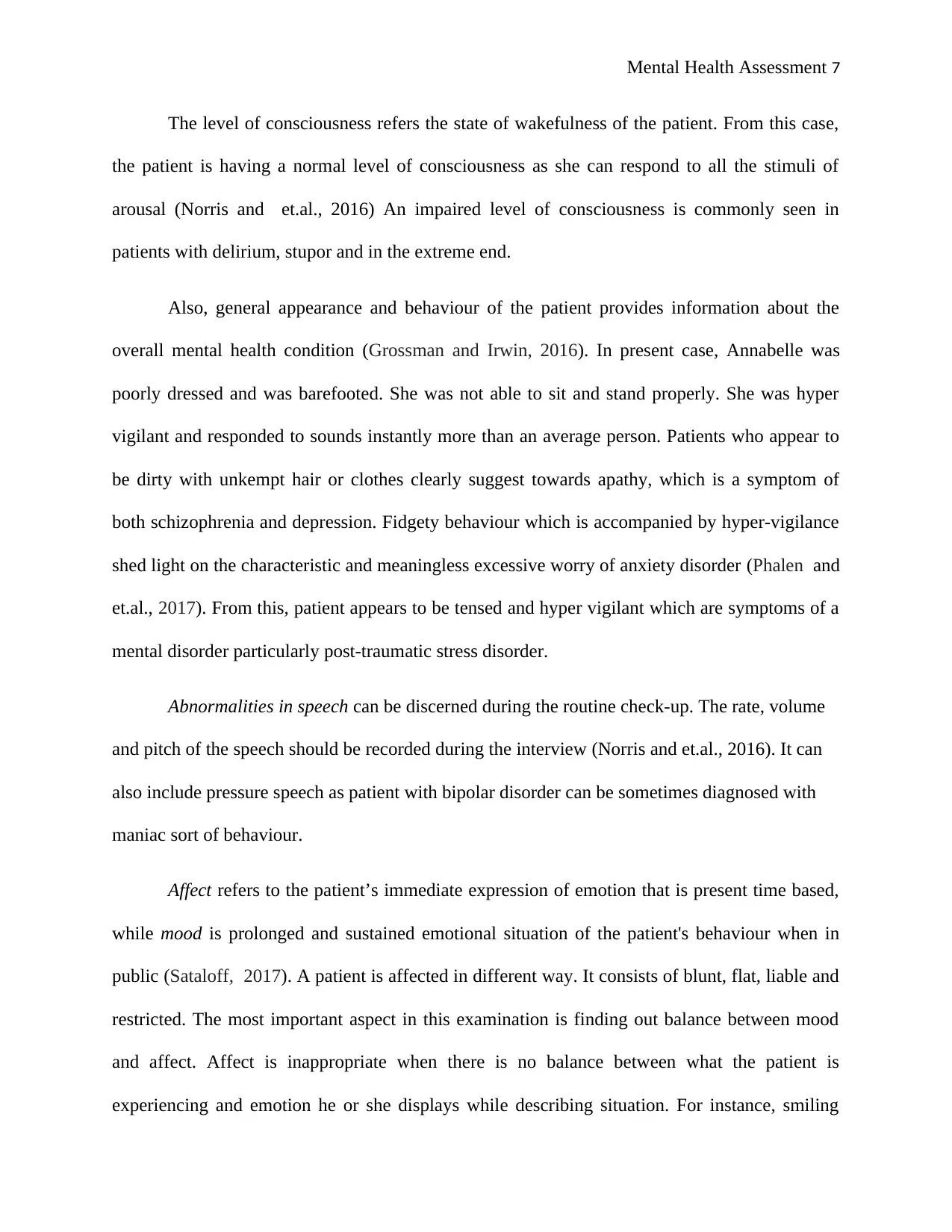
Mental Health Assessment 7
The level of consciousness refers the state of wakefulness of the patient. From this case,
the patient is having a normal level of consciousness as she can respond to all the stimuli of
arousal (Norris and et.al., 2016) An impaired level of consciousness is commonly seen in
patients with delirium, stupor and in the extreme end.
Also, general appearance and behaviour of the patient provides information about the
overall mental health condition (Grossman and Irwin, 2016). In present case, Annabelle was
poorly dressed and was barefooted. She was not able to sit and stand properly. She was hyper
vigilant and responded to sounds instantly more than an average person. Patients who appear to
be dirty with unkempt hair or clothes clearly suggest towards apathy, which is a symptom of
both schizophrenia and depression. Fidgety behaviour which is accompanied by hyper-vigilance
shed light on the characteristic and meaningless excessive worry of anxiety disorder (Phalen and
et.al., 2017). From this, patient appears to be tensed and hyper vigilant which are symptoms of a
mental disorder particularly post-traumatic stress disorder.
Abnormalities in speech can be discerned during the routine check-up. The rate, volume
and pitch of the speech should be recorded during the interview (Norris and et.al., 2016). It can
also include pressure speech as patient with bipolar disorder can be sometimes diagnosed with
maniac sort of behaviour.
Affect refers to the patient’s immediate expression of emotion that is present time based,
while mood is prolonged and sustained emotional situation of the patient's behaviour when in
public (Sataloff, 2017). A patient is affected in different way. It consists of blunt, flat, liable and
restricted. The most important aspect in this examination is finding out balance between mood
and affect. Affect is inappropriate when there is no balance between what the patient is
experiencing and emotion he or she displays while describing situation. For instance, smiling
The level of consciousness refers the state of wakefulness of the patient. From this case,
the patient is having a normal level of consciousness as she can respond to all the stimuli of
arousal (Norris and et.al., 2016) An impaired level of consciousness is commonly seen in
patients with delirium, stupor and in the extreme end.
Also, general appearance and behaviour of the patient provides information about the
overall mental health condition (Grossman and Irwin, 2016). In present case, Annabelle was
poorly dressed and was barefooted. She was not able to sit and stand properly. She was hyper
vigilant and responded to sounds instantly more than an average person. Patients who appear to
be dirty with unkempt hair or clothes clearly suggest towards apathy, which is a symptom of
both schizophrenia and depression. Fidgety behaviour which is accompanied by hyper-vigilance
shed light on the characteristic and meaningless excessive worry of anxiety disorder (Phalen and
et.al., 2017). From this, patient appears to be tensed and hyper vigilant which are symptoms of a
mental disorder particularly post-traumatic stress disorder.
Abnormalities in speech can be discerned during the routine check-up. The rate, volume
and pitch of the speech should be recorded during the interview (Norris and et.al., 2016). It can
also include pressure speech as patient with bipolar disorder can be sometimes diagnosed with
maniac sort of behaviour.
Affect refers to the patient’s immediate expression of emotion that is present time based,
while mood is prolonged and sustained emotional situation of the patient's behaviour when in
public (Sataloff, 2017). A patient is affected in different way. It consists of blunt, flat, liable and
restricted. The most important aspect in this examination is finding out balance between mood
and affect. Affect is inappropriate when there is no balance between what the patient is
experiencing and emotion he or she displays while describing situation. For instance, smiling
Paraphrase This Document
Need a fresh take? Get an instant paraphrase of this document with our AI Paraphraser
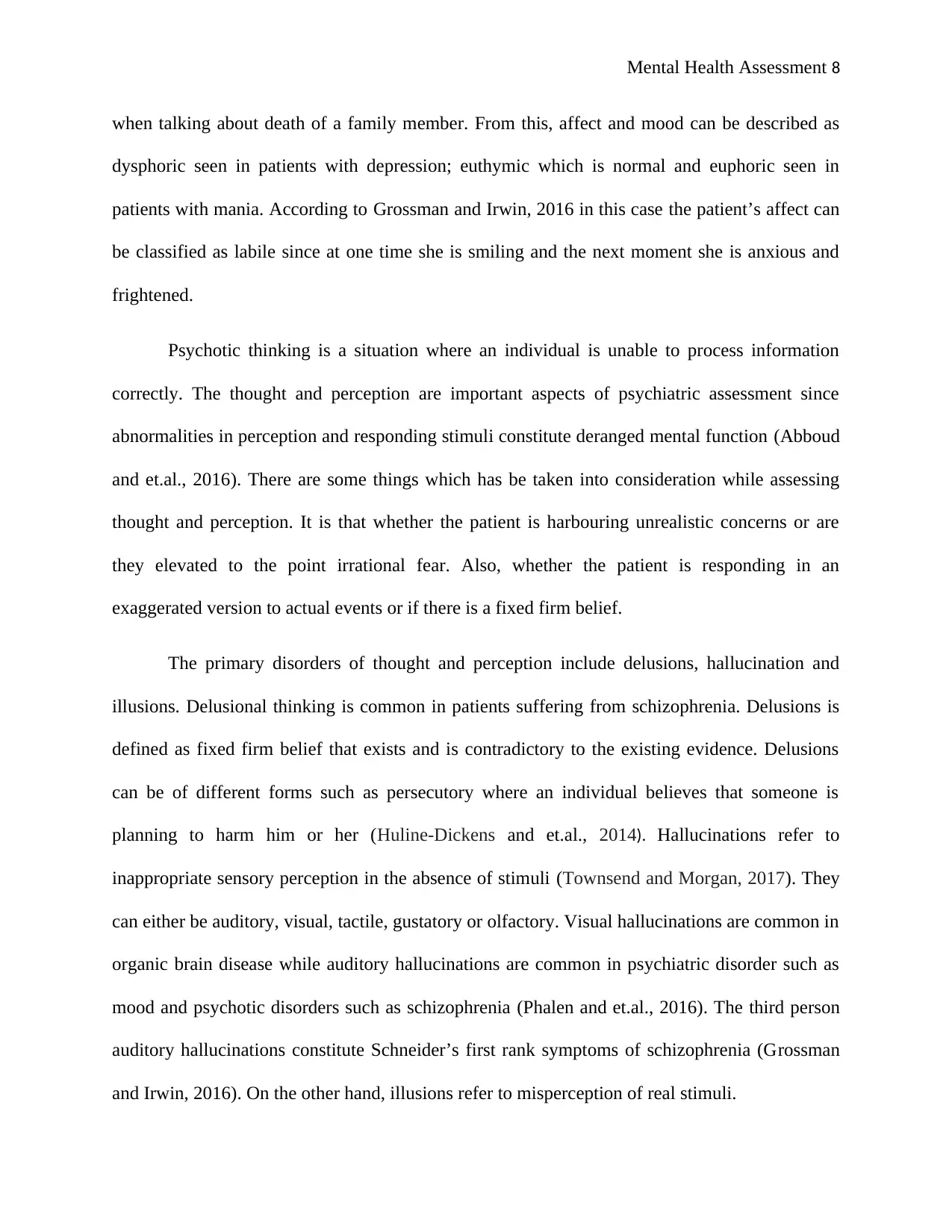
Mental Health Assessment 8
when talking about death of a family member. From this, affect and mood can be described as
dysphoric seen in patients with depression; euthymic which is normal and euphoric seen in
patients with mania. According to Grossman and Irwin, 2016 in this case the patient’s affect can
be classified as labile since at one time she is smiling and the next moment she is anxious and
frightened.
Psychotic thinking is a situation where an individual is unable to process information
correctly. The thought and perception are important aspects of psychiatric assessment since
abnormalities in perception and responding stimuli constitute deranged mental function (Abboud
and et.al., 2016). There are some things which has be taken into consideration while assessing
thought and perception. It is that whether the patient is harbouring unrealistic concerns or are
they elevated to the point irrational fear. Also, whether the patient is responding in an
exaggerated version to actual events or if there is a fixed firm belief.
The primary disorders of thought and perception include delusions, hallucination and
illusions. Delusional thinking is common in patients suffering from schizophrenia. Delusions is
defined as fixed firm belief that exists and is contradictory to the existing evidence. Delusions
can be of different forms such as persecutory where an individual believes that someone is
planning to harm him or her (Huline-Dickens and et.al., 2014). Hallucinations refer to
inappropriate sensory perception in the absence of stimuli (Townsend and Morgan, 2017). They
can either be auditory, visual, tactile, gustatory or olfactory. Visual hallucinations are common in
organic brain disease while auditory hallucinations are common in psychiatric disorder such as
mood and psychotic disorders such as schizophrenia (Phalen and et.al., 2016). The third person
auditory hallucinations constitute Schneider’s first rank symptoms of schizophrenia (Grossman
and Irwin, 2016). On the other hand, illusions refer to misperception of real stimuli.
when talking about death of a family member. From this, affect and mood can be described as
dysphoric seen in patients with depression; euthymic which is normal and euphoric seen in
patients with mania. According to Grossman and Irwin, 2016 in this case the patient’s affect can
be classified as labile since at one time she is smiling and the next moment she is anxious and
frightened.
Psychotic thinking is a situation where an individual is unable to process information
correctly. The thought and perception are important aspects of psychiatric assessment since
abnormalities in perception and responding stimuli constitute deranged mental function (Abboud
and et.al., 2016). There are some things which has be taken into consideration while assessing
thought and perception. It is that whether the patient is harbouring unrealistic concerns or are
they elevated to the point irrational fear. Also, whether the patient is responding in an
exaggerated version to actual events or if there is a fixed firm belief.
The primary disorders of thought and perception include delusions, hallucination and
illusions. Delusional thinking is common in patients suffering from schizophrenia. Delusions is
defined as fixed firm belief that exists and is contradictory to the existing evidence. Delusions
can be of different forms such as persecutory where an individual believes that someone is
planning to harm him or her (Huline-Dickens and et.al., 2014). Hallucinations refer to
inappropriate sensory perception in the absence of stimuli (Townsend and Morgan, 2017). They
can either be auditory, visual, tactile, gustatory or olfactory. Visual hallucinations are common in
organic brain disease while auditory hallucinations are common in psychiatric disorder such as
mood and psychotic disorders such as schizophrenia (Phalen and et.al., 2016). The third person
auditory hallucinations constitute Schneider’s first rank symptoms of schizophrenia (Grossman
and Irwin, 2016). On the other hand, illusions refer to misperception of real stimuli.
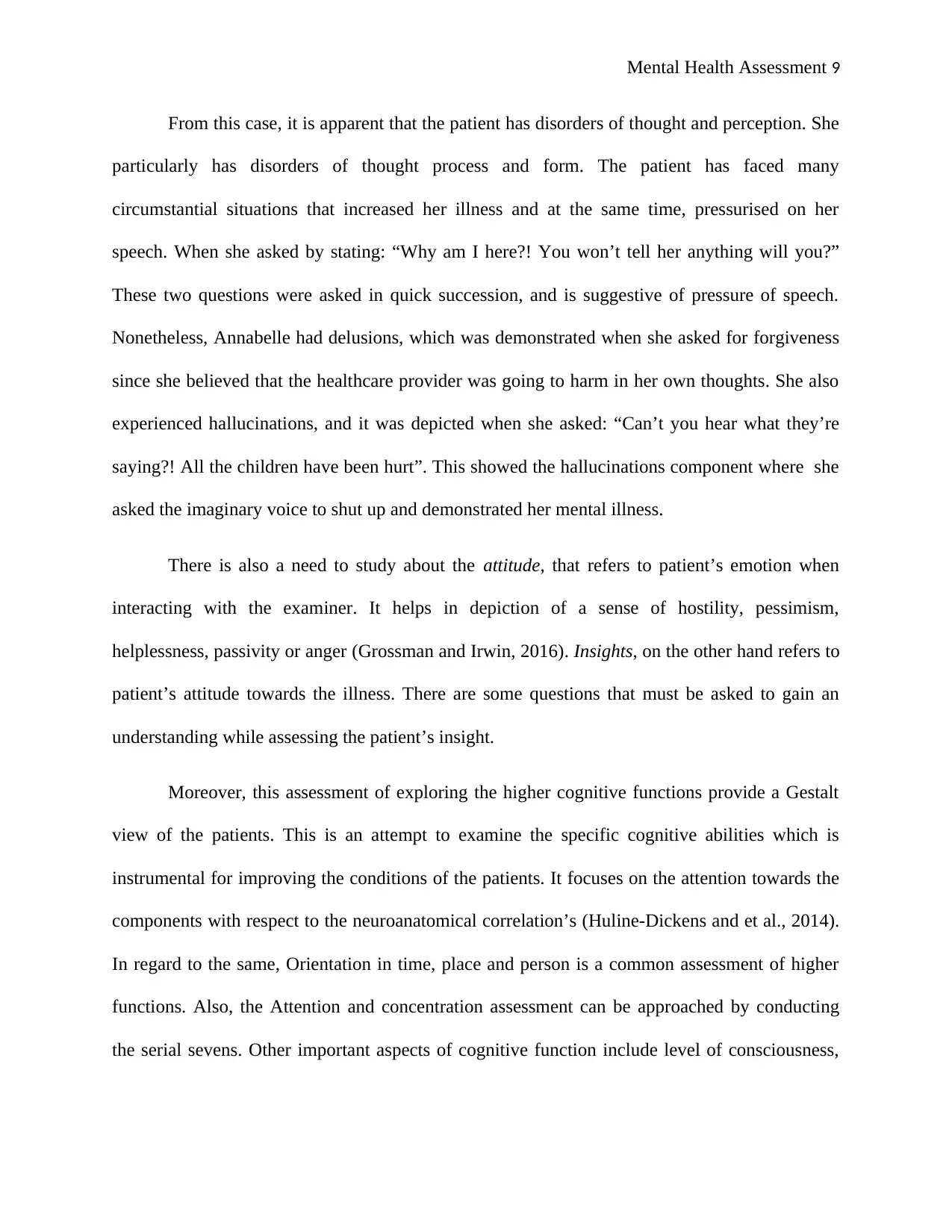
Mental Health Assessment 9
From this case, it is apparent that the patient has disorders of thought and perception. She
particularly has disorders of thought process and form. The patient has faced many
circumstantial situations that increased her illness and at the same time, pressurised on her
speech. When she asked by stating: “Why am I here?! You won’t tell her anything will you?”
These two questions were asked in quick succession, and is suggestive of pressure of speech.
Nonetheless, Annabelle had delusions, which was demonstrated when she asked for forgiveness
since she believed that the healthcare provider was going to harm in her own thoughts. She also
experienced hallucinations, and it was depicted when she asked: “Can’t you hear what they’re
saying?! All the children have been hurt”. This showed the hallucinations component where she
asked the imaginary voice to shut up and demonstrated her mental illness.
There is also a need to study about the attitude, that refers to patient’s emotion when
interacting with the examiner. It helps in depiction of a sense of hostility, pessimism,
helplessness, passivity or anger (Grossman and Irwin, 2016). Insights, on the other hand refers to
patient’s attitude towards the illness. There are some questions that must be asked to gain an
understanding while assessing the patient’s insight.
Moreover, this assessment of exploring the higher cognitive functions provide a Gestalt
view of the patients. This is an attempt to examine the specific cognitive abilities which is
instrumental for improving the conditions of the patients. It focuses on the attention towards the
components with respect to the neuroanatomical correlation’s (Huline-Dickens and et al., 2014).
In regard to the same, Orientation in time, place and person is a common assessment of higher
functions. Also, the Attention and concentration assessment can be approached by conducting
the serial sevens. Other important aspects of cognitive function include level of consciousness,
From this case, it is apparent that the patient has disorders of thought and perception. She
particularly has disorders of thought process and form. The patient has faced many
circumstantial situations that increased her illness and at the same time, pressurised on her
speech. When she asked by stating: “Why am I here?! You won’t tell her anything will you?”
These two questions were asked in quick succession, and is suggestive of pressure of speech.
Nonetheless, Annabelle had delusions, which was demonstrated when she asked for forgiveness
since she believed that the healthcare provider was going to harm in her own thoughts. She also
experienced hallucinations, and it was depicted when she asked: “Can’t you hear what they’re
saying?! All the children have been hurt”. This showed the hallucinations component where she
asked the imaginary voice to shut up and demonstrated her mental illness.
There is also a need to study about the attitude, that refers to patient’s emotion when
interacting with the examiner. It helps in depiction of a sense of hostility, pessimism,
helplessness, passivity or anger (Grossman and Irwin, 2016). Insights, on the other hand refers to
patient’s attitude towards the illness. There are some questions that must be asked to gain an
understanding while assessing the patient’s insight.
Moreover, this assessment of exploring the higher cognitive functions provide a Gestalt
view of the patients. This is an attempt to examine the specific cognitive abilities which is
instrumental for improving the conditions of the patients. It focuses on the attention towards the
components with respect to the neuroanatomical correlation’s (Huline-Dickens and et al., 2014).
In regard to the same, Orientation in time, place and person is a common assessment of higher
functions. Also, the Attention and concentration assessment can be approached by conducting
the serial sevens. Other important aspects of cognitive function include level of consciousness,
⊘ This is a preview!⊘
Do you want full access?
Subscribe today to unlock all pages.

Trusted by 1+ million students worldwide
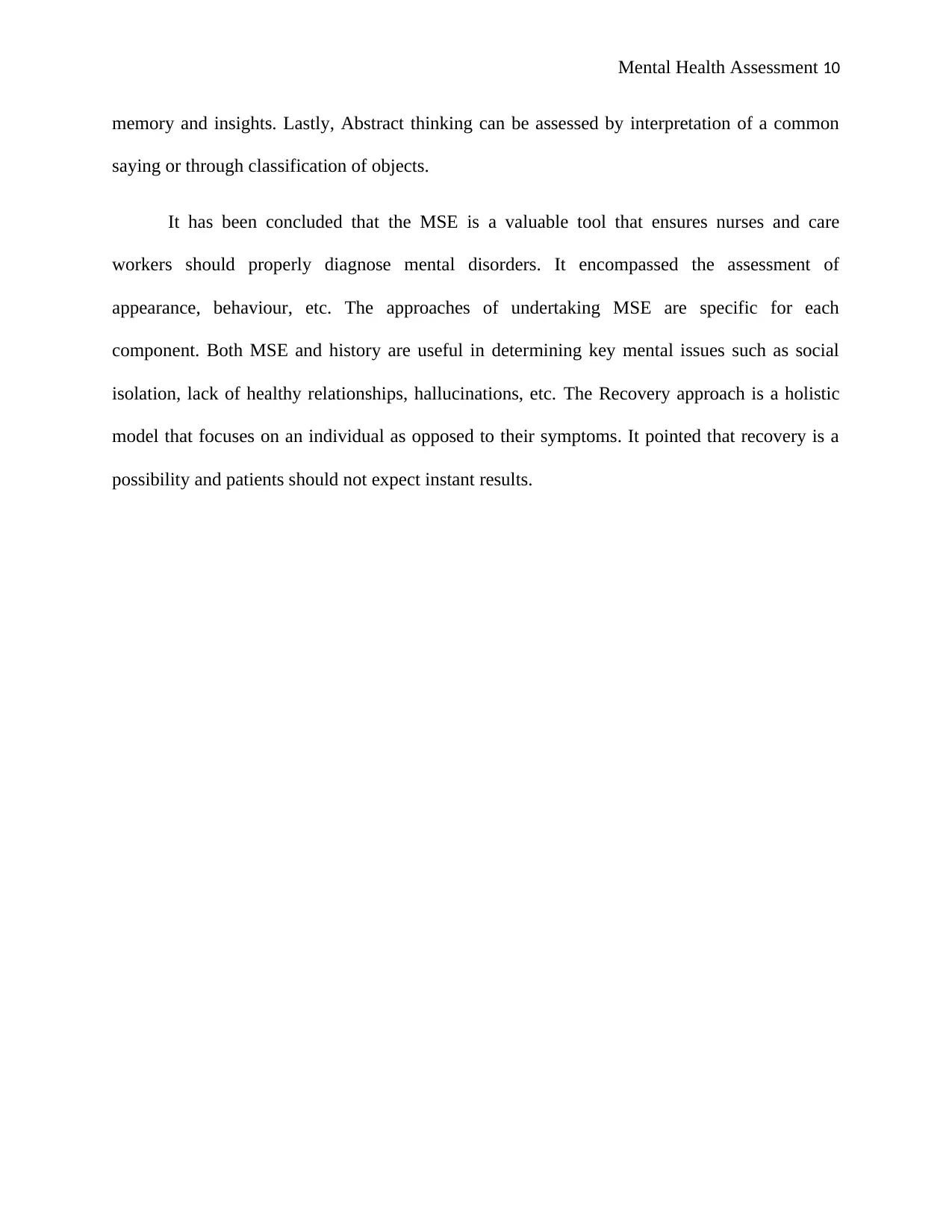
Mental Health Assessment 10
memory and insights. Lastly, Abstract thinking can be assessed by interpretation of a common
saying or through classification of objects.
It has been concluded that the MSE is a valuable tool that ensures nurses and care
workers should properly diagnose mental disorders. It encompassed the assessment of
appearance, behaviour, etc. The approaches of undertaking MSE are specific for each
component. Both MSE and history are useful in determining key mental issues such as social
isolation, lack of healthy relationships, hallucinations, etc. The Recovery approach is a holistic
model that focuses on an individual as opposed to their symptoms. It pointed that recovery is a
possibility and patients should not expect instant results.
memory and insights. Lastly, Abstract thinking can be assessed by interpretation of a common
saying or through classification of objects.
It has been concluded that the MSE is a valuable tool that ensures nurses and care
workers should properly diagnose mental disorders. It encompassed the assessment of
appearance, behaviour, etc. The approaches of undertaking MSE are specific for each
component. Both MSE and history are useful in determining key mental issues such as social
isolation, lack of healthy relationships, hallucinations, etc. The Recovery approach is a holistic
model that focuses on an individual as opposed to their symptoms. It pointed that recovery is a
possibility and patients should not expect instant results.
Paraphrase This Document
Need a fresh take? Get an instant paraphrase of this document with our AI Paraphraser
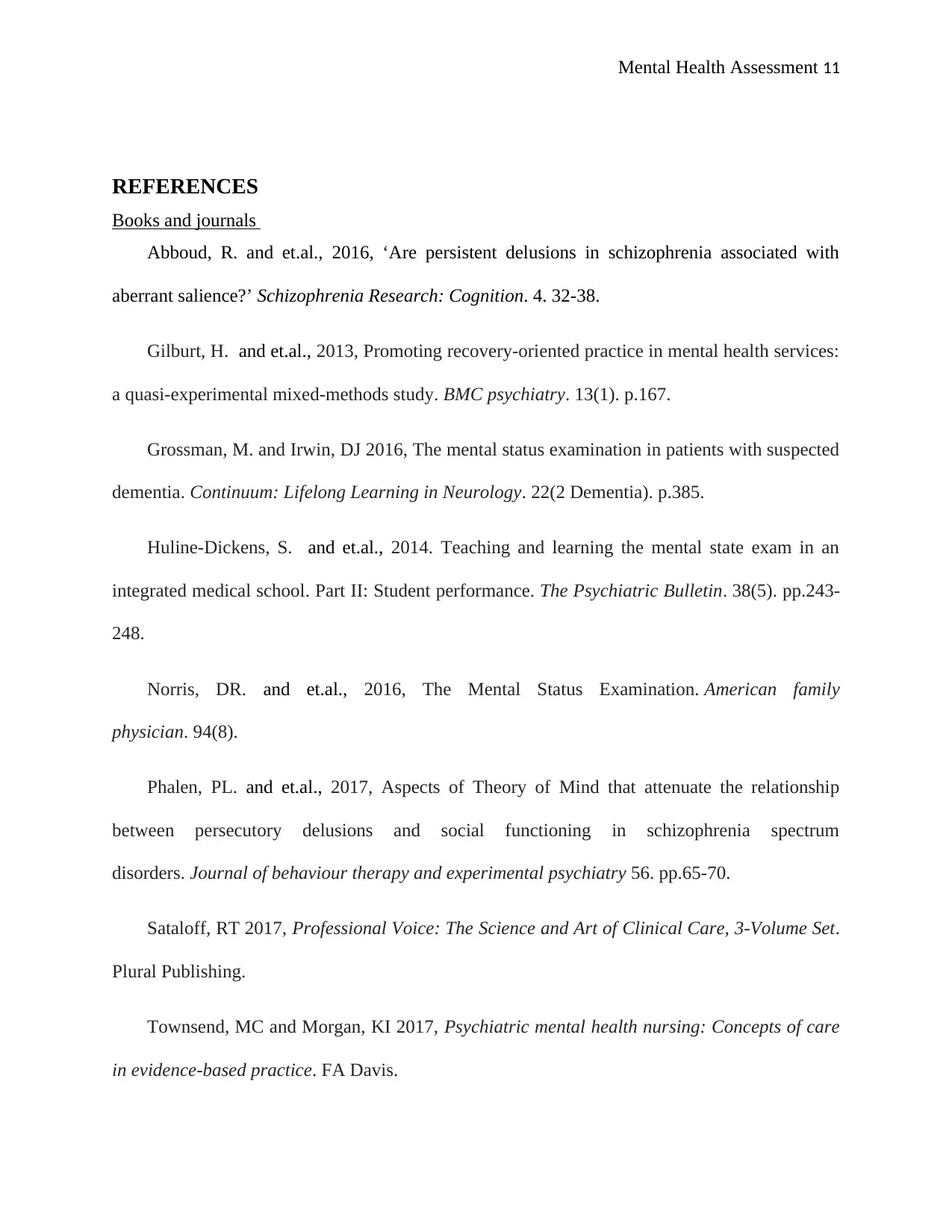
Mental Health Assessment 11
REFERENCES
Books and journals
Abboud, R. and et.al., 2016, ‘Are persistent delusions in schizophrenia associated with
aberrant salience?’ Schizophrenia Research: Cognition. 4. 32-38.
Gilburt, H. and et.al., 2013, Promoting recovery-oriented practice in mental health services:
a quasi-experimental mixed-methods study. BMC psychiatry. 13(1). p.167.
Grossman, M. and Irwin, DJ 2016, The mental status examination in patients with suspected
dementia. Continuum: Lifelong Learning in Neurology. 22(2 Dementia). p.385.
Huline-Dickens, S. and et.al., 2014. Teaching and learning the mental state exam in an
integrated medical school. Part II: Student performance. The Psychiatric Bulletin. 38(5). pp.243-
248.
Norris, DR. and et.al., 2016, The Mental Status Examination. American family
physician. 94(8).
Phalen, PL. and et.al., 2017, Aspects of Theory of Mind that attenuate the relationship
between persecutory delusions and social functioning in schizophrenia spectrum
disorders. Journal of behaviour therapy and experimental psychiatry 56. pp.65-70.
Sataloff, RT 2017, Professional Voice: The Science and Art of Clinical Care, 3-Volume Set.
Plural Publishing.
Townsend, MC and Morgan, KI 2017, Psychiatric mental health nursing: Concepts of care
in evidence-based practice. FA Davis.
REFERENCES
Books and journals
Abboud, R. and et.al., 2016, ‘Are persistent delusions in schizophrenia associated with
aberrant salience?’ Schizophrenia Research: Cognition. 4. 32-38.
Gilburt, H. and et.al., 2013, Promoting recovery-oriented practice in mental health services:
a quasi-experimental mixed-methods study. BMC psychiatry. 13(1). p.167.
Grossman, M. and Irwin, DJ 2016, The mental status examination in patients with suspected
dementia. Continuum: Lifelong Learning in Neurology. 22(2 Dementia). p.385.
Huline-Dickens, S. and et.al., 2014. Teaching and learning the mental state exam in an
integrated medical school. Part II: Student performance. The Psychiatric Bulletin. 38(5). pp.243-
248.
Norris, DR. and et.al., 2016, The Mental Status Examination. American family
physician. 94(8).
Phalen, PL. and et.al., 2017, Aspects of Theory of Mind that attenuate the relationship
between persecutory delusions and social functioning in schizophrenia spectrum
disorders. Journal of behaviour therapy and experimental psychiatry 56. pp.65-70.
Sataloff, RT 2017, Professional Voice: The Science and Art of Clinical Care, 3-Volume Set.
Plural Publishing.
Townsend, MC and Morgan, KI 2017, Psychiatric mental health nursing: Concepts of care
in evidence-based practice. FA Davis.

Mental Health Assessment 12
⊘ This is a preview!⊘
Do you want full access?
Subscribe today to unlock all pages.

Trusted by 1+ million students worldwide
1 out of 12
Related Documents
Your All-in-One AI-Powered Toolkit for Academic Success.
+13062052269
info@desklib.com
Available 24*7 on WhatsApp / Email
![[object Object]](/_next/static/media/star-bottom.7253800d.svg)
Unlock your academic potential
Copyright © 2020–2025 A2Z Services. All Rights Reserved. Developed and managed by ZUCOL.





![Mental Health and Wellbeing Report: [University Name], Semester 1](/_next/image/?url=https%3A%2F%2Fdesklib.com%2Fmedia%2Fimages%2Fob%2F76a73dbed3364ee18fbd23baba0664de.jpg&w=256&q=75)